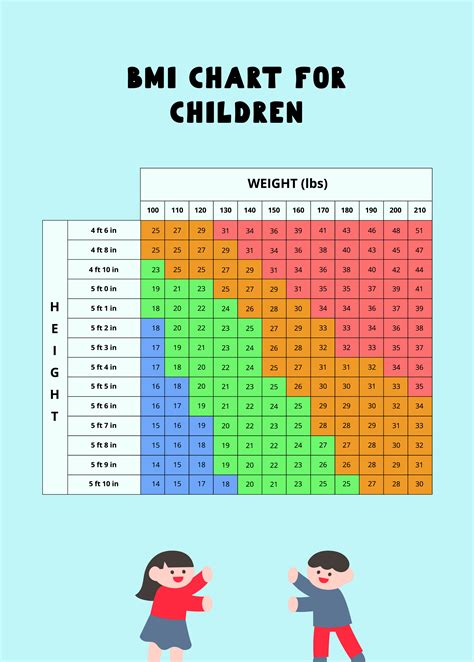Intro
Track your childs growth with our comprehensive Childrens Weight Chart Guide, featuring BMI calculators, growth percentile charts, and healthy weight management tips for kids, ensuring optimal development and nutrition.
As a parent, it's natural to be concerned about your child's health and wellbeing. One important aspect of their health is their weight, as being underweight or overweight can have significant effects on their overall health and development. A children's weight chart is a useful tool for tracking your child's weight and ensuring they are at a healthy weight for their age and height. In this article, we will explore the importance of monitoring your child's weight, how to use a children's weight chart, and provide guidance on how to support your child in maintaining a healthy weight.
Monitoring your child's weight is crucial, as it can help identify potential health problems early on. Being underweight or overweight can increase the risk of various health issues, such as diabetes, heart disease, and certain types of cancer. Additionally, being at a healthy weight can improve your child's self-esteem, energy levels, and overall quality of life. By using a children's weight chart, you can track your child's weight and height over time, and make informed decisions about their diet and lifestyle.
A children's weight chart is typically based on percentile rankings, which compare your child's weight to that of other children of the same age and sex. The chart is usually divided into different percentile ranges, such as underweight, normal weight, overweight, and obese. By plotting your child's weight on the chart, you can determine their percentile ranking and identify any potential weight-related issues. It's essential to remember that every child grows at a different rate, and what may be considered a healthy weight for one child may not be the same for another.
Understanding Children's Weight Charts

Children's weight charts are designed to provide a general guideline for assessing a child's weight status. The charts are usually based on data from large groups of children and take into account factors such as age, sex, and height. There are different types of children's weight charts, including those that use body mass index (BMI) and those that use weight-for-height. BMI is a widely used measure that calculates a person's weight in relation to their height. Weight-for-height charts, on the other hand, compare a child's weight to their height, without taking into account their age.
Types of Children's Weight Charts
There are several types of children's weight charts available, each with its own advantages and disadvantages. Some of the most common types of charts include: * BMI-for-age charts: These charts use BMI to assess a child's weight status, taking into account their age and sex. * Weight-for-height charts: These charts compare a child's weight to their height, without considering their age. * Percentile charts: These charts show the percentage of children who weigh less than or more than a given weight, for a specific age and sex.Using a Children's Weight Chart

Using a children's weight chart is relatively straightforward. To get started, you will need to know your child's weight, height, and age. You can then plot these values on the chart to determine their percentile ranking. It's essential to use a chart that is specific to your child's age and sex, as the growth patterns can vary significantly between boys and girls. You should also consult with your child's pediatrician or healthcare provider to ensure you are using the chart correctly and to discuss any concerns you may have about your child's weight.
Interpreting the Results
Once you have plotted your child's values on the chart, you can interpret the results to determine their weight status. The chart will typically show different percentile ranges, such as: * Underweight: less than 5th percentile * Normal weight: 5th-84th percentile * Overweight: 85th-94th percentile * Obese: 95th percentile or higherIt's essential to remember that these percentile ranges are only a guideline, and your child's healthcare provider may use different criteria to assess their weight status.
Maintaining a Healthy Weight

Maintaining a healthy weight is crucial for your child's overall health and wellbeing. There are several ways to support your child in achieving and maintaining a healthy weight, including:
- Encouraging a balanced diet: A healthy diet that includes plenty of fruits, vegetables, whole grains, and lean protein sources can help support your child's growth and development.
- Promoting physical activity: Regular physical activity can help your child burn energy and maintain a healthy weight.
- Limiting screen time: Excessive screen time can lead to a sedentary lifestyle, which can contribute to weight gain.
- Monitoring portion sizes: Teaching your child about portion sizes and encouraging them to eat until they are satisfied, rather than full, can help prevent overeating.
Supporting Your Child's Weight Loss Journey
If your child is overweight or obese, it's essential to provide them with support and guidance as they work towards a healthier weight. This can include: * Setting realistic goals: Encourage your child to set achievable goals, such as losing a certain amount of weight or increasing their physical activity levels. * Providing healthy food options: Offer your child a variety of healthy food options, and encourage them to make healthy choices. * Encouraging physical activity: Support your child in finding physical activities they enjoy, and encourage them to participate regularly. * Offering emotional support: Losing weight can be challenging, so it's essential to offer your child emotional support and encouragement throughout their journey.Common Challenges and Concerns

There are several common challenges and concerns that parents may face when it comes to their child's weight. These can include:
- Body image issues: Children who are overweight or obese may experience body image issues, which can affect their self-esteem and mental health.
- Social stigma: Overweight or obese children may face social stigma, which can make it challenging for them to participate in physical activities or social events.
- Nutrition knowledge: Parents may struggle to provide their child with a balanced diet, particularly if they have limited nutrition knowledge.
- Time constraints: Busy schedules can make it challenging for parents to find time to prepare healthy meals or engage in physical activity with their child.
Overcoming these Challenges
There are several ways to overcome these challenges and support your child in maintaining a healthy weight. These can include: * Seeking professional help: Consult with a registered dietitian or a healthcare provider to get personalized advice on supporting your child's weight loss journey. * Educating yourself: Learn about healthy eating and physical activity, and share this knowledge with your child. * Setting realistic expectations: Avoid setting unrealistic expectations or goals, and focus on making sustainable lifestyle changes. * Encouraging open communication: Talk to your child about their feelings and concerns, and encourage them to express themselves openly.Conclusion and Next Steps

In conclusion, monitoring your child's weight is an essential aspect of their overall health and wellbeing. By using a children's weight chart, you can track your child's weight and height over time, and make informed decisions about their diet and lifestyle. Remember to provide your child with support and guidance as they work towards a healthier weight, and seek professional help if you have concerns about their weight or overall health.
We invite you to share your thoughts and experiences on this topic. Have you used a children's weight chart to track your child's weight? What challenges have you faced, and how have you overcome them? Share your story in the comments below, and let's work together to support our children in achieving and maintaining a healthy weight.
What is a children's weight chart?
+A children's weight chart is a tool used to track a child's weight and height over time, and to assess their weight status.
How do I use a children's weight chart?
+To use a children's weight chart, you will need to know your child's weight, height, and age. Plot these values on the chart to determine their percentile ranking.
What are the benefits of using a children's weight chart?
+The benefits of using a children's weight chart include tracking your child's weight and height over time, identifying potential weight-related issues, and making informed decisions about their diet and lifestyle.
